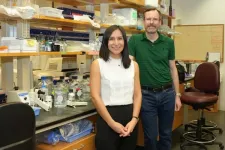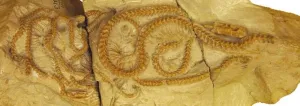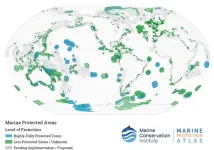(Press-News.org) The ISSCR is thrilled to announce Valentina Greco, Yale School of Medicine, Genetics Department and Yale Stem Cell Center USA, as its President. Her term began at the ISSCR 2024 Annual Meeting held in Hamburg, Germany that concluded on Saturday, 13 July 2024.
“I am honored to be taking on the role of ISSCR President for the coming year,” Dr. Greco said. “Building on Amander Clark’s efforts, my focus will be on people and scrutinizing processes so that they better support the diversity of needs of our members across identities including geographies and career stages. In turn this will increase opportunities for professional growth of our members and augment our collective impact. As I commit to this vision, I equally commit to speak with openness about the struggles that we have and will experience in order to make this vision a reality,” Dr. Greco added.
Valentina Greco was born in Palermo, Italy on 3 September 1972. She earned an undergraduate degree in Molecular Biology at the University of Palermo, Italy (1996) where she studied the role of tumor suppressors in cell cycle using in vitro system in the lab of Aldo Di Leonardo (1995-1998), her first academic research experience. She was accepted by Suzanne Eaton and the EMBL/MPI-CBG PhD program, Germany (1998-2002) and fell in love with microscopy and the power of developmental biology using fly wing imaginal disc as a model system to understand epithelial cell communication. Dr. Greco subsequentially completed a post-doc training in the Fuchs lab at the Rockefeller University (2003-2009) where she learned about the mammalian skin hair follicle as model system for stem cell driven regeneration. She was then hired as an Assistant Professor in the Genetics department at Yale School of Medicine by Richard Lifton and Haifan Lin (1 August 2009).
Dr. Greco is currently the Carolyn Walch Slayman Professor of Genetics as well as the Co-chair of Status of Women in Medicine (SWIM) at the Yale School of Medicine. She and members of her lab feel excited about visual driven research to study how cells behave in a living mouse. The team understands cell behaviors as an expression of the architectures and principles that govern the tissues these cells inhabit, much like human behaviors are an expression of the systems and structures in which they are embedded (e.g. a lab, an organization). The Greco lab is passionate about identifying the mechanisms that govern communication and cooperation to sustain function over a lifetime.
Dr. Greco has served in numerous leadership roles in the scientific community including many within the ISSCR over the last decade. She also serves on numerous additional boards including President Elect for the Society of Investigative Dermatology (SID), SID Board member 2016-2020, Member of the National Arthritis and Musculoskeletal and Skin Diseases Advisory Council (NAMSAC (2022-2024)), Member of the Yale Ciencia Academy Advisory Committee, Member of the 2030STEM Leadership Team and Secretary of Board of Directors of the Life Science Editors Foundation (2020-2023).
Greco lab research has been recognized by numerous accolades awarded to both lab members and Dr. Greco. She in particular has received the 2014 Women in Cell Biology Junior Award (WICB) for Excellence in Research from the American Society of Cell Biology (ASCB), the 2014 ISSCR (International Society for Stem Cell Research) Outstanding Young Investigator Award, the 2015 Robertson Stem Cell Investigator Award from the New York Stem Cell Foundation (NYSCF), the 2015 Mallinckrodt Scholar Award, the 2016 Early Career Award from the American Society of Cell Biology (ASCB), the 2016 HHMI Faculty Scholar Award, the 2017 Glenn Foundation Award, the 2017 Class of ‘61 Award by the Yale Cancer Center, the 2019 NIH DP1 Pioneer Award and the 2021 ISSCR Momentum Award. Dr. Greco finds it particularly meaningful to have received the 2018 Yale Mentoring Award in the Natural Sciences, the 2019 Yale Genetic Department Mentoring Award, the 2019 Yale Post-doc Mentoring Award.
The ISSCR is equally pleased to announce Hideyuki Okano, MD, PhD, Keio University, Japan is President-elect and will serve as president officially starting 1 July 2025. Lorenz Studer, MD, founding director of the Center for Stem Cell Biology and member of the Developmental Biology Program, Memorial Sloan Kettering Cancer Center, USA, is the new Vice President.
The following three members are newly elected to the ISSCR Board of Directors and beginning their three-year term: Jacqueline Barry, PhD, Cell and Gene Therapy Catapult, UK, Tenneille E. Ludwig, PhD, WiCell, USA, and Thomas A. Rando, MD, PhD, University of California, Los Angeles, USA.
The following members are starting their second, three-year term as a result of the 2024 election: Melissa Carpenter, PhD, Carpenter Consulting Corporation, USA, Malin Parmar, PhD, Lund University, Sweden, and Mitinori Saitou, MD, PhD, Kyoto University, Japan.
Learn more about the ISSCR Board of Directors.
About the International Society for Stem Cell Research
With nearly 5,000 members from more than 80 countries, the International Society for Stem Cell Research is the preeminent global, cross-disciplinary, science-based organization dedicated to stem cell research and its translation to the clinic. The ISSCR mission is to promote excellence in stem cell science and applications to human health. Additional information about stem cell science is available at AboutStemCells.org, an initiative of the Society to inform the public about stem cell research and its potential to improve human health.
###
END
Through precision medicine, the University of Virginia is working toward a world in which no more pink ribbons are necessary. To that end, Susan G. Komen announced support this summer for the UVA School of Engineering and Applied Science’s efforts to apply systems biology research to defeat breast cancer.
Komen announced a collective $10 million in research awards , including a $100,000 grant over two years to support the work of doctoral student Catalina Alvarez Yela, who is studying “triple negative” breast cancer, an aggressive type of invasive breast cancer ...
New recommendations for screening and treatment are based on the results of a major national study led at UCSF.
Results from a national study led by UC San Francisco informed the first guidelines at the federal level in the United States to detect and treat anal cancer precursor lesions in people with HIV to reduce the risk of developing anal cancer.
The guidelines were published on July 9 by a panel of experts in HIV care, utilizing findings from the Anal Cancer/HSIL Outcomes Research (ANCHOR) trial led by Joel ...
Surveillance cameras generate both video and audio outputs. Unlike video images recorded, the audio can be supplemented reliably as audio sources resist background interference and lighting variability. Creating a reliable way to use these audio sources to estimate the intensity of rainfall could open a new chapter in rainfall intensity estimation.
In a study published in Environmental Science and Ecotechnology, researchers created an audio dataset of six real-world rainfall events, named the Surveillance Audio Rainfall Intensity Dataset (SARID). ...
BUFFALO, NY- July 19, 2024 – A new research perspective was published in Oncoscience (Volume 11) on May 23, 2024, entitled, “Targeting inflammatory factors for chemoprevention and cancer interception to tackle malignant mesothelioma.”
In this perspective, researchers Joseph R. Testa, Yuwaraj Kadariya, and Joseph S. Friedberg from Fox Chase Cancer Center in Philadelphia, Pennsylvania, identify potential targets for mesothelioma prevention. Mesothelioma, an incurable cancer of the mesothelial lining, ...
A new species of fossil snake unearthed in Wyoming is rewriting our understanding of snake evolution. The discovery, based on four remarkably well-preserved specimens found curled together in a burrow, reveals a new species named Hibernophis breithaupti. This snake lived in North America 34 million years ago and sheds light on the origin and diversification of boas and pythons.
Hibernophis breithaupti has unique anatomical features, in part because the specimens are articulated—meaning they were found all in one piece with the bones still arranged in the proper order—which is unusual for fossil snakes. Researchers believe it may be ...
The international study, co-authored by the Department of Sociology and the Leverhulme Centre for Demographic Science’s Dr Aashish Gupta and Professor Ridhi Kashyap, reveals that life expectancy in India suffered large and unequal declines during the COVID-19 pandemic.
Overall, mortality across India was 17% higher in 2020 compared to 2019, implying 1.19 million excess deaths in India. This extrapolated estimate is about eight times higher than the official number of COVID-19 deaths in India, and 1.5 times higher than the World Health Organization’s estimates.
Ridhi ...
A new study conducted by the Centre for Urban Mental Health at the University of Amsterdam finds that, in a sample of 156,000 UK residents aged 40 and up, urban living is linked to lower levels of well-being, social satisfaction, and economic satisfaction. Urban residents also exhibit greater psychological inequality. The study identifies a ‘Goldilocks zone’ between cities and rural areas, where the highest satisfaction and most equal scores are observed.
The percentage of people living in cities has surged from 10% in the 1910s to a projected 68% by 2050. This shift means ...
Marine Protected Areas (MPAs) are having a positive spillover effect, producing more “trophy-size” fish just outside of the fully protected areas, and the effect is growing stronger over time. That’s according to research led by University of Hawaiʻi at Mānoa scientists at the Hawaiʻi Institute of Marine Biology (HIMB) published today in Science Advances. The research provides the first global assessment of the benefits of MPAs. “Trophy-size” refers to fish that are exceptionally long or heavy and are considered a rare, ...
CHAMPAIGN, Ill. — Understanding how soft materials fail under stress is critical for solving engineering challenges as disparate as pharmaceutical technology and landslide prevention. A new study linking a spectrum of soft material behaviors — previously thought to be unrelated — led researchers to identify a new parameter they call the brittility factor, which allows them to simplify soft material failure behavior. This will ultimately help engineers design better materials that meet future challenges.
University of Illinois Urbana-Champaign chemical and biomolecular engineering professor Simon Rogers and graduate student Krutarth Kamani specialize ...
DURHAM, N.C. – The world around us is constantly being flash photographed by adaptive radar systems. From salt flats to mountains and everything in between, adaptive radar is used to detect, locate and track moving objects. Just because human eyes can’t see these ultra-high frequency (UHF) ranges doesn’t mean they’re not taking pictures.
Although adaptive radar systems have been around since World War II, they’ve hit a fundamental performance wall in the past couple of decades. But with the help of modern AI approaches and lessons learned from computer vision, researchers at Duke University have broken through that wall, and they want to bring everyone ...









